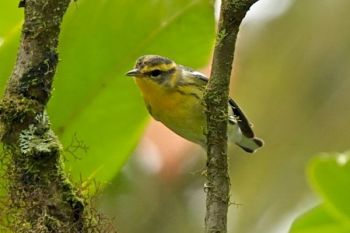
Photo © by Charlie M
Point Pelee National Park, Ontario, Canada, 18 May 2005
Setophaga fusca
Dendroica fusca
Identification
L. 13 cm (5"); W. 9-10 g
- Back boldly striped
Breeding male:
- Black and white
- Vivid orange throat, crown patch, and eyebrow continuing down behind black auriculars
- Large white wing patch
- Orange-yellowish on breast and flanks
Female and Immature Male: Similar to male, but has yellow throat, 2 wingbars instead of wingpatch, and lighter auriculars.
Autumn plumage identifiers are the 2 white wing bars and yellowish tinge to patch on front of crown, supercilium, sides of neck, throat (surrounding the auriculars), breast and upper flanks.
Similar Species
In Costa Rica, Flame-throated Warbler is the only other wood warbler with an orange throat but has no white on the back or in the wings.
Distribution
Breeds from Saskatchewan east to Nova Scotia, south to Great Lakes, southern New England, and in the Appalachians to northern Georgia. Widespread in east and midwest in migration.
Winters in the tropics from Costa Rica south to Peru and Bolivia.
Rare but regular vagrant to the western United States.
Accidental vagrant to Greenland (2 records), Iceland (1 record), and Great Britain (2 records).

Photo © by Stanley Jones
Reserva Las Gralaras, Pichincha Province, Mindo, Ecuador, November 2014
Taxonomy
This is a monotypic species[1].
Formerly placed in genus Dendroica.
Habitat
Most numerous in mixed forests of hemlock (Tsuga), spruce (Picea), and various hardwoods, usually ranging high in trees; in winter in cloud forests and humid tropical montane forests. In migration found in nearly any type of woods.
Behaviour
They usually spend their time gleaning in the upper canopy.
Diet
Their diet during the breeding season consists almost entirely of insects and smaller invertebrates, particularly spiders, beetles and caterpillars. During the winter they add fruit and berries to their fare.
Breeding
The clutch consists of 4 brown-spotted white eggs which are laid in a twig nest lined with lichens, mosses, and hair, usually placed high in a large conifer.
Vocalisation
Song: is thin and wiry and increases in speed, becoming almost inaudible to humans, sleet-sleet-sleet-sleet-sleetee-sleeeee. Also tiddly-tiddly-tiddly-tiddly at same speed and pitch.
Call: chip
References
- Clements, J. F., P. C. Rasmussen, T. S. Schulenberg, M. J. Iliff, T. A. Fredericks, J. A. Gerbracht, D. Lepage, A. Spencer, S. M. Billerman, B. L. Sullivan, M. Smith, and C. L. Wood. 2024. The eBird/Clements checklist of Birds of the World: v2024. Downloaded from https://www.birds.cornell.edu/clementschecklist/download/
- Lepage D. (2020) Avibase. Retrieved 25 November 2020
- Morse, D. H. (2020). Blackburnian Warbler (Setophaga fusca), version 1.0. In Birds of the World (A. F. Poole, Editor). Cornell Lab of Ornithology, Ithaca, NY, USA. https://doi.org/10.2173/bow.bkbwar.01
Recommended Citation
- BirdForum Opus contributors. (2025) Blackburnian Warbler. In: BirdForum, the forum for wild birds and birding. Retrieved 13 May 2025 from https://www.birdforum.net/opus/Blackburnian_Warbler
External Links
Search the Gallery using the scientific name:
Search the Gallery using the common name:
GSearch checked for 2020 platform.




